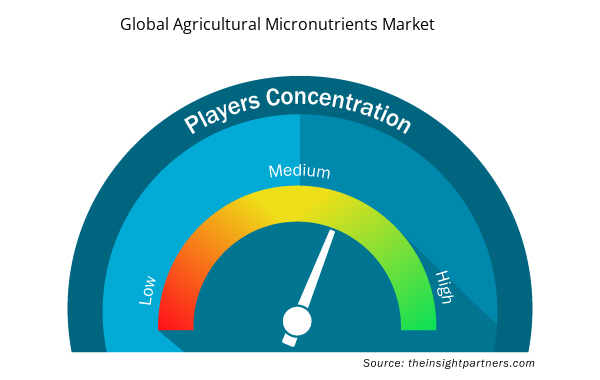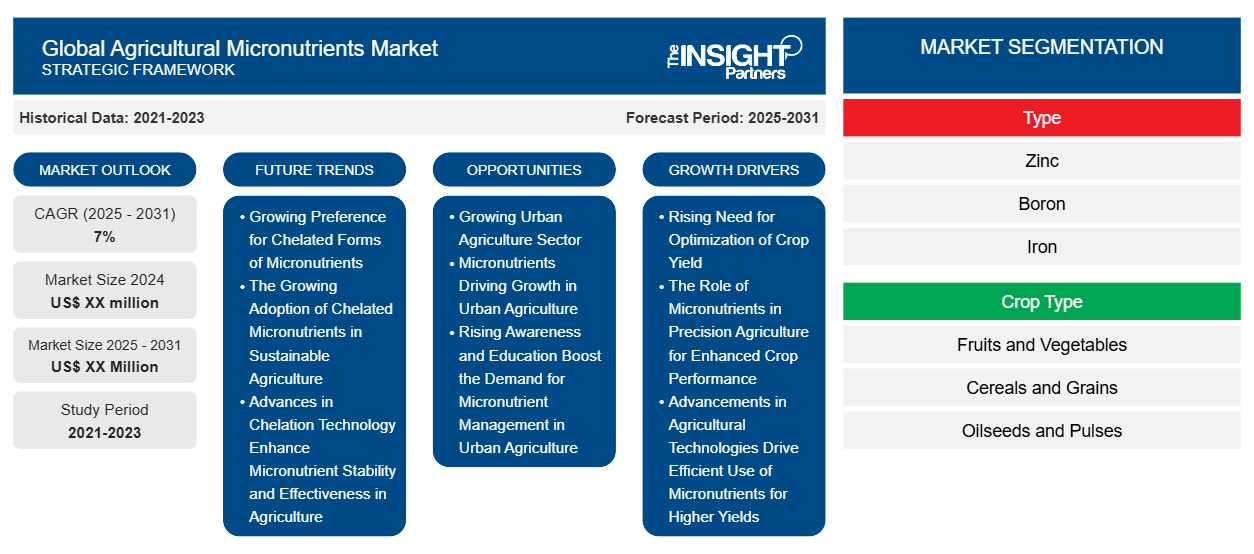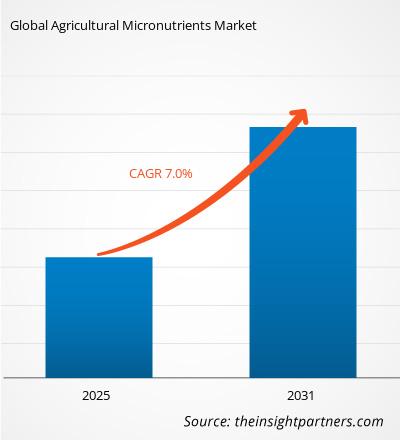من المتوقع أن يسجل سوق المغذيات الدقيقة الزراعية معدل نمو سنوي مركب بنسبة 7٪ من عام 2023 إلى عام 2031، مع توسع حجم السوق من XX مليون دولار أمريكي في عام 2023 إلى XX مليون دولار أمريكي بحلول عام 2031.
تم تقسيم التقرير حسب النوع (الزنك، البورون، الحديد، الموليبدينوم، النحاس، المنغنيز، وغيرها). كما يقدم التقرير تحليلاً بناءً على نوع المحصول (الفواكه والخضروات، الحبوب والحبوب، البذور الزيتية والبقوليات، وغيرها). بناءً على النموذج، تم تقسيم التقرير إلى (مخلّب وغير مخلّب). بناءً على طريقة التطبيق، تم تقسيم التقرير إلى (التربة، الأوراق، التسميد بالري، وغيرها). تم تقسيم التحليل العالمي بشكل أكبر على المستوى الإقليمي والدول الرئيسية. يقدم التقرير القيمة بالدولار الأمريكي للتحليل والشرائح المذكورة أعلاه.
غرض التقرير
يهدف تقرير سوق المغذيات الدقيقة الزراعية الصادر عن The Insight Partners إلى وصف المشهد الحالي والنمو المستقبلي وأهم العوامل الدافعة والتحديات والفرص. وسيوفر هذا رؤى لمختلف أصحاب المصلحة في الأعمال التجارية، مثل:
- مزودي/مصنعي التكنولوجيا: لفهم ديناميكيات السوق المتطورة ومعرفة فرص النمو المحتملة، وتمكينهم من اتخاذ قرارات استراتيجية مستنيرة.
- المستثمرون: إجراء تحليل شامل للاتجاهات فيما يتعلق بمعدل نمو السوق، وتوقعات السوق المالية، والفرص المتاحة عبر سلسلة القيمة.
- الهيئات التنظيمية: لتنظيم السياسات ومراقبة الأنشطة في السوق بهدف تقليل الانتهاكات والحفاظ على ثقة المستثمرين ودعم سلامة السوق واستقرارها.
تجزئة سوق المغذيات الدقيقة الزراعية
يكتب
- الزنك
- البورون
- حديد
- الموليبدينوم
- نحاس
- المنغنيز
نوع المحصول
- الفواكه والخضروات
- الحبوب والحبوب
- البذور الزيتية والبقوليات
استمارة
- المخلبي وغير المخلبي
الجغرافيا
- أمريكا الشمالية
- أوروبا
- آسيا والمحيط الهادئ
- أمريكا الجنوبية والوسطى
- الشرق الأوسط وأفريقيا
الجغرافيا
- أمريكا الشمالية
- أوروبا
- آسيا والمحيط الهادئ
- أمريكا الجنوبية والوسطى
- الشرق الأوسط وأفريقيا
قم بتخصيص هذا التقرير ليناسب متطلباتك
ستحصل على تخصيص لأي تقرير - مجانًا - بما في ذلك أجزاء من هذا التقرير، أو تحليل على مستوى الدولة، وحزمة بيانات Excel، بالإضافة إلى الاستفادة من العروض والخصومات الرائعة للشركات الناشئة والجامعات
- احصل على أهم اتجاهات السوق الرئيسية لهذا التقرير.ستتضمن هذه العينة المجانية تحليلاً للبيانات، بدءًا من اتجاهات السوق وحتى التقديرات والتوقعات.
محركات نمو سوق المغذيات الدقيقة الزراعية
- الحاجة المتزايدة لتحسين إنتاج المحاصيل: إن أحد التأثيرات الضخمة التي ستلحق بسوق المغذيات الدقيقة الزراعية هو زيادة تحسين الإنتاج. وسوف يأتي هذا من ميل المزارعين إلى تعزيز إنتاجية المحاصيل وجودتها، مما يؤدي بالتالي إلى زيادة الطلب على المغذيات الدقيقة مثل الزنك والحديد والمنجنيز. وقد كان هذا أحد المكونات الأساسية لصحة النبات وإنتاجيته، وخاصة في ظل الظروف البيئية المعاكسة.
- دور المغذيات الدقيقة في الزراعة الدقيقة لتحسين أداء المحاصيل: مع النمو السريع للسكان، تأتي الدعوة إلى تحسين الإنتاج الزراعي، جنبًا إلى جنب مع انعدام الأمن الغذائي. لسد فجوات النقص في العناصر التي من شأنها أن تحد من أداء المحاصيل، يتم جلب الأسمدة وتعديلات التربة بشكل متزايد إلى الحقول من قبل المزارعين. هذا التركيز على الزراعة الدقيقة يزيد من الوعي بدور المغذيات الدقيقة في الممارسة المستدامة للزراعة.
- إن التقدم في التقنيات الزراعية يدفع إلى الاستخدام الفعّال للمغذيات الدقيقة لتحقيق غلة أعلى: وعلى نحو مماثل، فإن كثافة استخدام المغذيات الدقيقة العالية تأتي أيضاً من التقنيات الزراعية. ومع تحسن أنظمة اختبار التربة وإدارة المغذيات، يصبح المزارعون قادرين عموماً على زيادة مدخلاتهم بعناية أكبر، ليس فقط لتحقيق غلة أكثر ربحية ولكن أيضاً لاستخدام الموارد بشكل أكثر اقتصاداً لضمان ربحية أكبر في العمليات الزراعية.
الاتجاهات المستقبلية لسوق المغذيات الدقيقة الزراعية
- تفضيل متزايد للأشكال المخلبية من المغذيات الدقيقة: أحد الاتجاهات الجديدة في المغذيات الدقيقة الزراعية هو الطلب المتزايد على الأشكال المخلبية من المغذيات الدقيقة. المغذيات الدقيقة المخلبية هي مغذيات دقيقة مخلبية بجزيئات عضوية، والتي توفر توافرًا بيولوجيًا أكبر من الأشكال التقليدية، وبالتالي امتصاصًا أكبر من قبل النباتات وأداءً أفضل للمحاصيل.
- الاستخدام المتزايد للمغذيات الدقيقة المخلبية في الزراعة المستدامة: من الفوائد الأخرى لاستخدامات المغذيات الدقيقة المخلبية التي تم الإبلاغ عنها من خلال اكتشاف المزارعين هي تصحيح أوجه القصور في المغذيات المحددة في التربة. ومع تصاعد الوعي البيئي المتزايد تجاه إدارة المغذيات، يتم تبني هذه الأشكال بسهولة كطريقة لمزيد من المزارعين لتحسين صحة النبات والإنتاجية. يتوافق هذا الاتجاه مع الدعوة الموجهة إلى جميع الدول في جميع أنحاء العالم لتبني الزراعة المستدامة.
- إن التقدم في تكنولوجيا الاستخلاب يعزز استقرار المغذيات الدقيقة وفعاليتها في الزراعة: إن التقدم في تكنولوجيا الاستخلاب من محركات أخرى. تحقيق المزيد من التحسينات في طريقة صياغة المغذيات الدقيقة المخلبية لتحقيق استقرار أكبر، وبالتالي فعالية أكبر. إن مثل هذه التركيبات الجديدة من المغذيات الدقيقة المخلبية تجعل من السهل تطبيقها وبالتالي تعطي نتائج أفضل، وهو ما يفرض استيعابًا أوسع وأكثر منهجية داخل القطاعات الزراعية.
فرص سوق المغذيات الدقيقة الزراعية
- قطاع الزراعة الحضرية المتنامي: في الواقع، يشكل قطاع الزراعة الحضرية المتنامي مصدرًا كبيرًا جدًا للنمو في سوق المغذيات الدقيقة الزراعية. ومع تقدم الاعتماد على زراعة الغذاء داخل المدن كطريقة أساسية لتلبية متطلبات الغذاء، أصبحت إدارة المغذيات مهمة بشكل متزايد. تلعب المغذيات الدقيقة دورًا حيويًا في تعزيز إنتاجية أنظمة الزراعة المدمجة هذه.
- المغذيات الدقيقة تدفع النمو في الزراعة الحضرية: الأفكار الجديدة في هذا المجال هي الزراعة العمودية والزراعة المائية؛ ولا يمكن لهذه الزراعة أن تعمل بدون مغذيات دقيقة التركيب. والمغذيات الدقيقة هي التي ستزيد من نمو النباتات في البيئات الخاضعة للرقابة، مثل الزراعة الحضرية. ويستخدم المزارعون الحضريون هذه المغذيات الدقيقة لتحقيق غلات أعلى في المساحات الضيقة الصغيرة. وأصبحت منتجات المغذيات الدقيقة هذه مطلوبة بشكل متزايد لاستخدامها في البيئات الزراعية الحضرية.
- إن زيادة الوعي والتعليم يعززان الطلب على إدارة المغذيات الدقيقة في الزراعة الحضرية: إن زيادة الوعي العام فيما يتعلق ببرامج التعليم والتدريب في المدن يخلق طلبًا متزايدًا على الوعي بإدارة المغذيات أيضًا. إن زيادة الوعي بفوائد المغذيات الدقيقة في الزراعة الحضرية تضيف إلى الاتجاه المتزايد لمثل هذه المنتجات. وبالتالي، سيستمر هذا في نمو سوق المغذيات الدقيقة الزراعية مع استمرار نمو اتجاه الزراعة الحضرية.
رؤى إقليمية حول سوق المغذيات الدقيقة الزراعية العالمية
لقد قام المحللون في Insight Partners بشرح الاتجاهات والعوامل الإقليمية المؤثرة على سوق المغذيات الدقيقة الزراعية العالمية طوال فترة التوقعات بشكل شامل. يناقش هذا القسم أيضًا قطاعات سوق المغذيات الدقيقة الزراعية العالمية والجغرافيا في جميع أنحاء أمريكا الشمالية وأوروبا ومنطقة آسيا والمحيط الهادئ والشرق الأوسط وأفريقيا وأمريكا الجنوبية والوسطى.

- احصل على البيانات الإقليمية المحددة لسوق المغذيات الدقيقة الزراعية العالمية
نطاق تقرير سوق المغذيات الدقيقة الزراعية العالمية
| سمة التقرير | تفاصيل |
|---|---|
| حجم السوق في عام 2023 | XX مليون دولار أمريكي |
| حجم السوق بحلول عام 2031 | XX مليون دولار أمريكي |
| معدل النمو السنوي المركب العالمي (2023 - 2031) | 7% |
| البيانات التاريخية | 2021-2022 |
| فترة التنبؤ | 2024-2031 |
| القطاعات المغطاة | حسب النوع
|
| المناطق والدول المغطاة | أمريكا الشمالية
|
| قادة السوق وملفات تعريف الشركات الرئيسية |
|
كثافة اللاعبين في سوق المغذيات الدقيقة الزراعية العالمية: فهم تأثيرها على ديناميكيات الأعمال
يشهد سوق المغذيات الدقيقة الزراعية العالمية نموًا سريعًا، مدفوعًا بالطلب المتزايد من المستخدم النهائي بسبب عوامل مثل تفضيلات المستهلكين المتطورة والتقدم التكنولوجي والوعي المتزايد بفوائد المنتج. ومع ارتفاع الطلب، تعمل الشركات على توسيع عروضها والابتكار لتلبية احتياجات المستهلكين والاستفادة من الاتجاهات الناشئة، مما يؤدي إلى زيادة نمو السوق.
تشير كثافة اللاعبين في السوق إلى توزيع الشركات أو المؤسسات العاملة في سوق أو صناعة معينة. وهي تشير إلى عدد المنافسين (اللاعبين في السوق) الموجودين في مساحة سوق معينة نسبة إلى حجمها أو قيمتها السوقية الإجمالية.
الشركات الرئيسية العاملة في سوق المغذيات الدقيقة الزراعية العالمية هي:
- باسف اس اي
- شركة كورومانديل الدولية المحدودة
- شركة نيوترين المحدودة
- شركة موزاييك
- مجموعة حيفا
إخلاء المسؤولية : الشركات المذكورة أعلاه ليست مرتبة بأي ترتيب معين.

- احصل على نظرة عامة على أهم اللاعبين الرئيسيين في سوق المغذيات الدقيقة الزراعية العالمية
نقاط البيع الرئيسية
- التغطية الشاملة: يغطي التقرير بشكل شامل تحليل المنتجات والخدمات والأنواع والمستخدمين النهائيين لسوق المغذيات الدقيقة الزراعية، مما يوفر صورة شاملة.
- تحليل الخبراء: تم تجميع التقرير على أساس الفهم العميق لخبراء الصناعة والمحللين.
- معلومات محدثة: يضمن التقرير أهمية الأعمال التجارية بسبب تغطيته للمعلومات الحديثة واتجاهات البيانات.
- خيارات التخصيص: يمكن تخصيص هذا التقرير لتلبية متطلبات العملاء المحددة وبما يتناسب مع استراتيجيات العمل بشكل مناسب.
وبالتالي، يمكن أن يساعد تقرير البحث حول سوق المغذيات الدقيقة الزراعية في تمهيد الطريق لفك شفرة وفهم سيناريو الصناعة وآفاق النمو. ورغم وجود بعض المخاوف المشروعة، فإن الفوائد الإجمالية لهذا التقرير تميل إلى التفوق على العيوب.
- التحليل التاريخي (سنتان)، السنة الأساسية، التوقعات (7 سنوات) مع معدل النمو السنوي المركب
- تحليل PEST و SWOT
- حجم السوق والقيمة / الحجم - عالميًا وإقليميًا وقطريًا
- الصناعة والمنافسة
- مجموعة بيانات Excel


- Wire Harness Market
- Pharmacovigilance and Drug Safety Software Market
- Grant Management Software Market
- Mail Order Pharmacy Market
- Vision Guided Robotics Software Market
- Medical Enzyme Technology Market
- Sports Technology Market
- Digital Language Learning Market
- GNSS Chip Market
- Smart Water Metering Market

Report Coverage
Revenue forecast, Company Analysis, Industry landscape, Growth factors, and Trends

Segment Covered
This text is related
to segments covered.

Regional Scope
North America, Europe, Asia Pacific, Middle East & Africa, South & Central America

Country Scope
This text is related
to country scope.
الأسئلة الشائعة
Growing Preference for Chelated Forms of Micronutrients is expected to be the key market trends.
Based on geography, Asia Pacific held the largest share of the agricultural micronutrients market.
Based on type, zinc, is expected to witness the fastest growth during the forecast period
BASF SE, Coromandel International Limited, Nutrien Ltd are some of the key players operating in the agricultural micronutrients market
Rising Need for Optimization of Crop Yield is driving the market growth
The Agricultural Micronutrients Market is estimated to witness a CAGR of 7% from 2023 to 2031
Trends and growth analysis reports related to Chemicals and Materials : READ MORE..
The List of Companies
1. BASF SE
2. Coromandel International Limited
3. Nutrien Ltd.
4. The Mosaic Company
5. Haifa Group
6. Yara International ASA
7. Helena Agri-Enterprises LLC
8. Valagro S.p.A
9. Sigma AgriScience, LLC
10. Aries Agro Limited
11. Nufarm Limited
12. AgroLiquid
13. Agrium
14. Akzonobel
15. Dow Chemical
16. ADAMA Agricultural Solutions Ltd.
17. Agrium Inc.
18. Akzo Nobel N.V.
19. Auriga Industries A/S
20.Bayer Crop.
The Insight Partners performs research in 4 major stages: Data Collection & Secondary Research, Primary Research, Data Analysis and Data Triangulation & Final Review.
- Data Collection and Secondary Research:
As a market research and consulting firm operating from a decade, we have published and advised several client across the globe. First step for any study will start with an assessment of currently available data and insights from existing reports. Further, historical and current market information is collected from Investor Presentations, Annual Reports, SEC Filings, etc., and other information related to company’s performance and market positioning are gathered from Paid Databases (Factiva, Hoovers, and Reuters) and various other publications available in public domain.
Several associations trade associates, technical forums, institutes, societies and organization are accessed to gain technical as well as market related insights through their publications such as research papers, blogs and press releases related to the studies are referred to get cues about the market. Further, white papers, journals, magazines, and other news articles published in last 3 years are scrutinized and analyzed to understand the current market trends.
- Primary Research:
The primarily interview analysis comprise of data obtained from industry participants interview and answers to survey questions gathered by in-house primary team.
For primary research, interviews are conducted with industry experts/CEOs/Marketing Managers/VPs/Subject Matter Experts from both demand and supply side to get a 360-degree view of the market. The primary team conducts several interviews based on the complexity of the markets to understand the various market trends and dynamics which makes research more credible and precise.
A typical research interview fulfils the following functions:
- Provides first-hand information on the market size, market trends, growth trends, competitive landscape, and outlook
- Validates and strengthens in-house secondary research findings
- Develops the analysis team’s expertise and market understanding
Primary research involves email interactions and telephone interviews for each market, category, segment, and sub-segment across geographies. The participants who typically take part in such a process include, but are not limited to:
- Industry participants: VPs, business development managers, market intelligence managers and national sales managers
- Outside experts: Valuation experts, research analysts and key opinion leaders specializing in the electronics and semiconductor industry.
Below is the breakup of our primary respondents by company, designation, and region:

Once we receive the confirmation from primary research sources or primary respondents, we finalize the base year market estimation and forecast the data as per the macroeconomic and microeconomic factors assessed during data collection.
- Data Analysis:
Once data is validated through both secondary as well as primary respondents, we finalize the market estimations by hypothesis formulation and factor analysis at regional and country level.
- Macro-Economic Factor Analysis:
We analyse macroeconomic indicators such the gross domestic product (GDP), increase in the demand for goods and services across industries, technological advancement, regional economic growth, governmental policies, the influence of COVID-19, PEST analysis, and other aspects. This analysis aids in setting benchmarks for various nations/regions and approximating market splits. Additionally, the general trend of the aforementioned components aid in determining the market's development possibilities.
- Country Level Data:
Various factors that are especially aligned to the country are taken into account to determine the market size for a certain area and country, including the presence of vendors, such as headquarters and offices, the country's GDP, demand patterns, and industry growth. To comprehend the market dynamics for the nation, a number of growth variables, inhibitors, application areas, and current market trends are researched. The aforementioned elements aid in determining the country's overall market's growth potential.
- Company Profile:
The “Table of Contents” is formulated by listing and analyzing more than 25 - 30 companies operating in the market ecosystem across geographies. However, we profile only 10 companies as a standard practice in our syndicate reports. These 10 companies comprise leading, emerging, and regional players. Nonetheless, our analysis is not restricted to the 10 listed companies, we also analyze other companies present in the market to develop a holistic view and understand the prevailing trends. The “Company Profiles” section in the report covers key facts, business description, products & services, financial information, SWOT analysis, and key developments. The financial information presented is extracted from the annual reports and official documents of the publicly listed companies. Upon collecting the information for the sections of respective companies, we verify them via various primary sources and then compile the data in respective company profiles. The company level information helps us in deriving the base number as well as in forecasting the market size.
- Developing Base Number:
Aggregation of sales statistics (2020-2022) and macro-economic factor, and other secondary and primary research insights are utilized to arrive at base number and related market shares for 2022. The data gaps are identified in this step and relevant market data is analyzed, collected from paid primary interviews or databases. On finalizing the base year market size, forecasts are developed on the basis of macro-economic, industry and market growth factors and company level analysis.
- Data Triangulation and Final Review:
The market findings and base year market size calculations are validated from supply as well as demand side. Demand side validations are based on macro-economic factor analysis and benchmarks for respective regions and countries. In case of supply side validations, revenues of major companies are estimated (in case not available) based on industry benchmark, approximate number of employees, product portfolio, and primary interviews revenues are gathered. Further revenue from target product/service segment is assessed to avoid overshooting of market statistics. In case of heavy deviations between supply and demand side values, all thes steps are repeated to achieve synchronization.
We follow an iterative model, wherein we share our research findings with Subject Matter Experts (SME’s) and Key Opinion Leaders (KOLs) until consensus view of the market is not formulated – this model negates any drastic deviation in the opinions of experts. Only validated and universally acceptable research findings are quoted in our reports.
We have important check points that we use to validate our research findings – which we call – data triangulation, where we validate the information, we generate from secondary sources with primary interviews and then we re-validate with our internal data bases and Subject matter experts. This comprehensive model enables us to deliver high quality, reliable data in shortest possible time.


 احصل على عينة مجانية لهذا التقرير
احصل على عينة مجانية لهذا التقرير